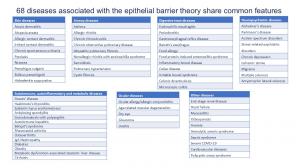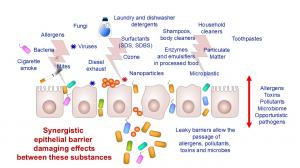DISEASES OF THE EPITHELIAL BARRIER DEFECT
Epithelial barrier theory-related diseases, microbial dysbiosis and inflammation
• To explain the growing prevalence of allergic, autoimmune and neuropsychiatric diseases, the epithelial barrier theory is a central focus of worldwide opinion leaders.
• According to the epithelial barrier theory, exposure to environmental toxic substances in humans and animals damages the epithelium, the layer of cells that covers the surface of our skin, digestive tract, lungs, and eyes. Epithelial barrier dysfunction is induced by together with microbial dysbiosis, immune system activation, along with the development of inflammation in the tissues.
• Together with worldwide opinion leaders, we identified 68 epithelial barrier-related diseases, including skin diseases, airway diseases, digestive tract diseases, neuropsychiatric diseases, autoimmune, autoinflammatory and metabolic diseases, ocular diseases.
• These diseases associated with the epithelial barrier theory share common features, such as increased prevalence after the 1960s or 2000s with the same method of diagnosis, microbial dysbiosis with decreased commensals and increased opportunistic pathogens, immune system activation and inflammation in the affected tissues as well as in the circulation.
• In 1960s these diseases were affecting 20-30 million humans which increased by 100 times to 2 billion patients. The world’s population increased by 2 times in the meantime.
• With the contribution of 48 international opinion leaders and 642 references this immense study shows the evidence and similarities in the epidemiology, epithelial barrier dysfunction, microbial dysbiosis, and tissue inflammation in 68 diseases that substantially affect the human health.
• The immense increase in the prevalence of these diseases caused a huge healthcare burden consuming more than 10% of the GDP of every country for health care. The increased socioeconomic burden made the healthcare sector the main locomotive of the world’s economy.
• The onset and exacerbations of these diseases is attributed to a damaged epithelial barrier and inflammation triggered by hazardous substances originating from industrialization, urbanization and westernized lifestyles, such as air pollution, microplastics, nanoplastics, several surfactant formulations in detergents, household cleaners, dishwashers, hand sanitizers, disinfectants, toothpastes, and processed food emulsifiers and additives. Epithelial barrier damaging agents initiate the crosstalk between the epithelial barrier, microbiota, and an immune response, as reported in numerous studies on the pathogenesis of epithelial barrier-associated diseases.
• The studies presented within our research emphasize the significant implications of the epithelial barrier theory in unraveling the pathogenesis of chronic non-communicable diseases and to elucidate novel strategies for the development of preventive or therapeutic approaches.
Download article here: https://doi.org/10.1111/all.16318
Correspondence: Prof. Dr. Cezmi A. Akdis, MD
Director
Swiss Institute of Allergy and Asthma Research (SIAF)
Herman-Burchard-Strasse 9
CH-7265 Davos Wolfgang
Phone: +41 78 7388284
akdisac@siaf.uzh.ch
Web: https://epithelialbarriertheory.com
Cezmi Akdis
Swiss Institute of Allergy and Asthma Research
+41 787388284
email us here
Visit us on social media:
Facebook
X
LinkedIn
Instagram
Legal Disclaimer:
EIN Presswire provides this news content "as is" without warranty of any kind. We do not accept any responsibility or liability for the accuracy, content, images, videos, licenses, completeness, legality, or reliability of the information contained in this article. If you have any complaints or copyright issues related to this article, kindly contact the author above.




